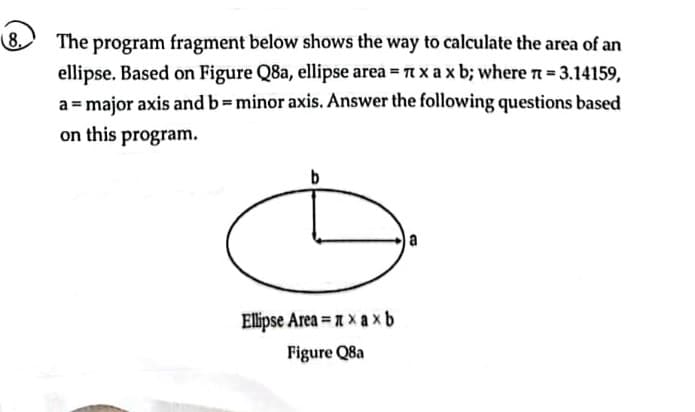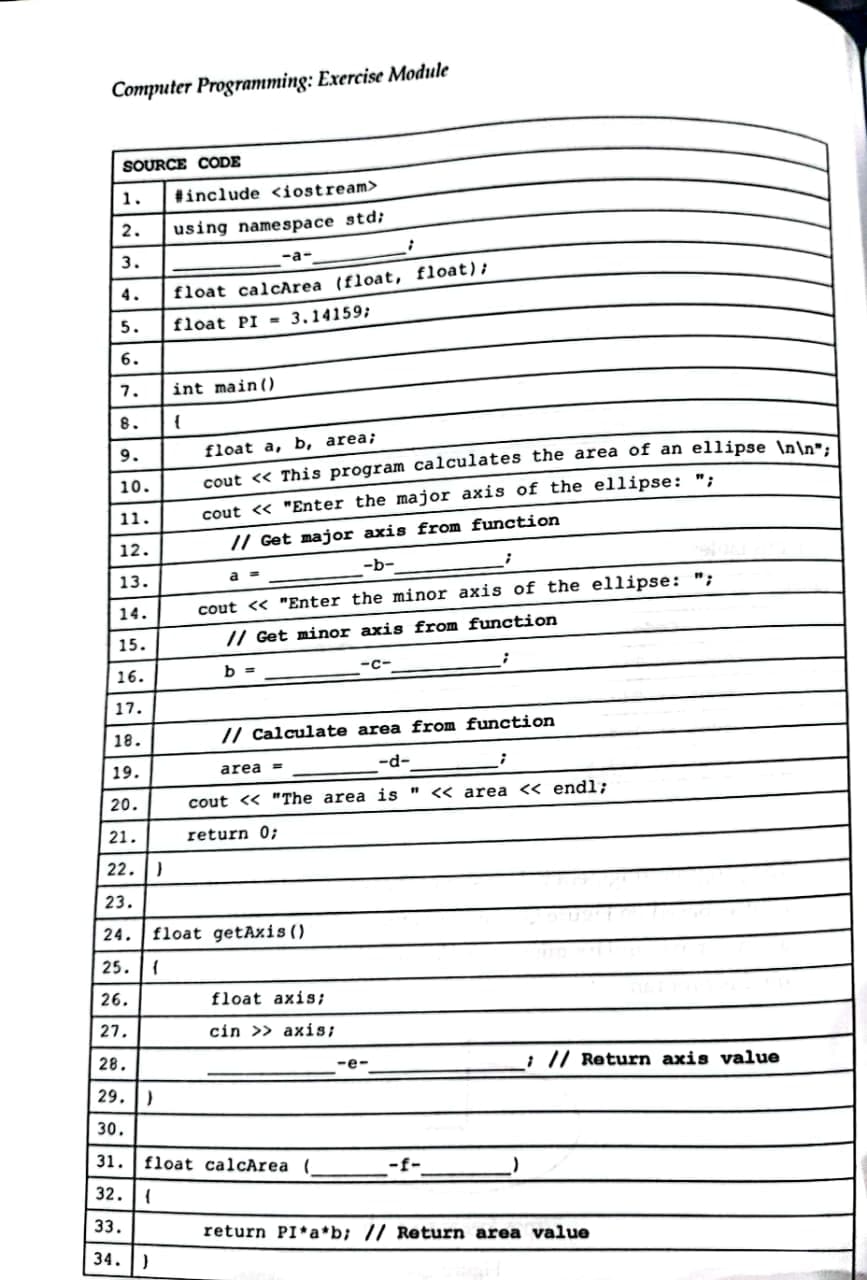Computer Programming: Exercise Module SOURCE CODE 1. tinclude 2. using namespace std; 3. -a- 4. float calcArea (float, float); 5. float PI = 3.14159; 6. 7. int main () 8. 9. float a, b, area; 10. cout <« This program calculates the area of an ellipse \nlnt 11. cout « "Enter the major axis of the ellipse: "; 12. // Get major axis from function -b- 13. a = 14. cout « "Enter the minor axis of the ellipse: "; 15. // Get minor axis from function 16. b = -c- 17. 18. // Calculate area from function 19. area = -d- 20. cout << "The area is " << area << end%; 21. return 0; 22. ) 23. 24. float getAxis () 25. 26. float axis; 27. cín >> axis; 28. -e- ; |/ Return axis value 29. ) 30. 31. float calcArea ( -f- 32. 33. return PI*a*b; // Return area value 34. )
Computer Programming: Exercise Module SOURCE CODE 1. tinclude 2. using namespace std; 3. -a- 4. float calcArea (float, float); 5. float PI = 3.14159; 6. 7. int main () 8. 9. float a, b, area; 10. cout <« This program calculates the area of an ellipse \nlnt 11. cout « "Enter the major axis of the ellipse: "; 12. // Get major axis from function -b- 13. a = 14. cout « "Enter the minor axis of the ellipse: "; 15. // Get minor axis from function 16. b = -c- 17. 18. // Calculate area from function 19. area = -d- 20. cout << "The area is " << area << end%; 21. return 0; 22. ) 23. 24. float getAxis () 25. 26. float axis; 27. cín >> axis; 28. -e- ; |/ Return axis value 29. ) 30. 31. float calcArea ( -f- 32. 33. return PI*a*b; // Return area value 34. )
C++ for Engineers and Scientists
4th Edition
ISBN:9781133187844
Author:Bronson, Gary J.
Publisher:Bronson, Gary J.
Chapter5: Repetition Statements
Section5.3: Interactive While Loops
Problem 7E
Related questions
Concept explainers
Max Function
Statistical function is of many categories. One of them is a MAX function. The MAX function returns the largest value from the list of arguments passed to it. MAX function always ignores the empty cells when performing the calculation.
Power Function
A power function is a type of single-term function. Its definition states that it is a variable containing a base value raised to a constant value acting as an exponent. This variable may also have a coefficient. For instance, the area of a circle can be given as:
Question

Transcribed Image Text:(8.
The program fragment below shows the way to calculate the area of an
ellipse. Based on Figure Q8a, ellipse area = x a x b; where n= 3.14159,
%3D
a = major axis and b=minor axis. Answer the following questions based
%3D
on this program.
a
Ellipse Area = a xaxb
Figure Q8a

Transcribed Image Text:Computer Programming: Exercise Module
SOURCE CODE
1.
#include <iostream>
2.
using namespace std;
3.
-a-
4.
float calcArea (float, float);
5.
float PI = 3.14159;
6.
7.
int main ()
8.
9.
float a, b, area;
cout <« This program calculates the area of an ellipse \n\n,
10.
11.
cout <« "Enter the major axis of the ellipse: ";
12.
// Get major axis from function
-b-
13.
14.
cout <« "Enter the minor axis of the ellipse: ";
15.
// Get minor axis from function
16.
b =
-c-
17.
18.
// Calculate area from function
19.
area =
-d-
20.
cout <« "The area is " << area << endl;
21.
return 0;
22.
23.
24.
float getAxis ()
25. {
26.
float axis;
27.
cín >> axis;
28.
; |/ Return axis value
-e-
29.
30.
31. float calcArea (
-f-
32.
33.
return PI*a*b; // Return area value
34.
Expert Solution
This question has been solved!
Explore an expertly crafted, step-by-step solution for a thorough understanding of key concepts.
Step by step
Solved in 5 steps with 2 images

Knowledge Booster
Learn more about
Need a deep-dive on the concept behind this application? Look no further. Learn more about this topic, computer-science and related others by exploring similar questions and additional content below.Recommended textbooks for you

C++ for Engineers and Scientists
Computer Science
ISBN:
9781133187844
Author:
Bronson, Gary J.
Publisher:
Course Technology Ptr

C++ for Engineers and Scientists
Computer Science
ISBN:
9781133187844
Author:
Bronson, Gary J.
Publisher:
Course Technology Ptr